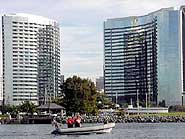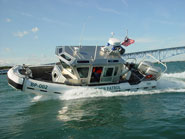Mission
The priority mission of the Border Patrol is preventing terrorists and terrorists weapons, including weapons of mass destruction, from entering the United States. Undaunted by scorching desert heat or freezing northern winters, they work tirelessly as vigilant protectors of our Nation's borders.
While the Border Patrol has changed dramatically since its inception in 1924, its primary mission remains unchanged: to detect and prevent the illegal entry of individuals into the United States. Together with other law enforcement officers, the Border Patrol helps maintain borders that work - facilitating the flow of legal immigration and goods while preventing the illegal trafficking of people and contraband.
The Border Patrol is specifically responsible for patrolling nearly 6,000 miles of Mexican and Canadian international land borders and over 2,000 miles of coastal waters surrounding the Florida Peninsula and the island of Puerto Rico. Agents work around the clock on assignments, in all types of terrain and weather conditions. Agents also work in many isolated communities throughout the United States.
Border Patrol Staffing
Since 1924, the Border Patrol has grown from a handful of mounted agents patrolling desolate areas along U.S. borders to today's dynamic work force of over 21,000 agents at the end of FY 2012.
To ensure that the increased staffing and new resources provided by Congress were deployed in the most effective and efficient manner possible, the Immigration and Naturalization Service acted in early 1994 to develop and implement the agency's first National Border Patrol Strategy.
The Border Patrol continues to operate an aggressive recruiting program to bring new Border Patrol agents into the government. Read more about Careers with the Border Patrol.
All Border Patrol agents spend 13 weeks in training at the Border Patrol Academy in Artesia, New Mexico, which is a component of the Federal Law Enforcement Training Center.
Border Patrol Operations
The primary mission of the Border Patrol is to protect our Nation by reducing the likelihood that dangerous people and capabilities enter the United States between the ports of entry. This is accomplished by maintaining surveillance, following up leads, responding to electronic sensor alarms and aircraft sightings, and interpreting and following tracks. Some of the major activities include maintaining traffic checkpoints along highways leading from border areas, conducting city patrol and transportation check, and anti-smuggling investigations.
Often, the border is a barely discernible line in uninhabited deserts, canyons, or mountains. The Border Patrol utilizes a variety of equipment and methods to accomplish its mission in such diverse terrain. Electronic sensors are placed at strategic locations along the border to detect people or vehicles entering the country illegally. Video monitors and night vision scopes are also used to detect illegal entries. Agents patrol the border in vehicles, boats, and afoot. In some areas, the Border Patrol even employs horses, all-terrain motorcycles, bicycles, and snowmobiles.
Linewatch and Signcutting
Linewatch operations are conducted near international boundaries and coast lines in areas of Border Patrol jurisdiction t o prevent the illegal entry and smuggling of individuals into the United States and to intercept those who do enter illegally before they can escape from border areas. Signcutting is the detection and the interpretation of any disturbances in natural terrain conditions that indicate the presence or passage of people, animals, or vehicles.
o prevent the illegal entry and smuggling of individuals into the United States and to intercept those who do enter illegally before they can escape from border areas. Signcutting is the detection and the interpretation of any disturbances in natural terrain conditions that indicate the presence or passage of people, animals, or vehicles.
Traffic Checkpoints
Traffic checks are conducted on major highways leading away from the border to (1) detect and apprehend individuals attempting to travel further into the interior of the United States after evading detection at the border and (2) to detect illegal narcotics.
Transportation Checks
These are inspections of interior-bound conveyances, which include buses, commercial aircraft, passenger and freight trains, and marine craft.
Marine Patrol
Along the coastal waterways of the United States and Puerto Rico and interior waterways common to the United States and Canada, the Border Patrol conducts border control activities from the decks of marine craft of various sizes. The Border Patrol maintains over 109 vessels, ranging from blue-water craft to inflatable-hull craft, in 16 sectors, in addition to Headquarters special operations components.
Horse and Bike Patrol
Horse units patrol remote areas along the international boundary that are inaccessible to standard all-terrain vehicles. Bike patrol aids city patrol and is used over rough terrain to support linewatch.
Border Patrol Apprehensions
In FY 2012, Border Patrol agents made over 364,000 arrests of people illegally entering the country. Considerable success has been achieved in restoring integrity and safety to the Southwest border, by implementing our border-control strategy. These include Operation Gatekeeper in San Diego, CA, Operation Hold the Line in El Paso, TX, Operation Rio Grande in McAllen, TX, Operation Safeguard in Tucson, AZ, and the Arizona Border Control Initiative (ABCI) along the Arizona border.
Drug Seizures
An increase in smuggling activities has pushed the Border Patrol to the front line of the U.S. war on drugs. Our role as the primary drug-interdicting organization along the Southwest border continues to expand. The heightened presence of Border Patrol agents along the Southwest border has burdened narcotic traffickers and human smugglers. In FY 2012, Border Patrol agents on the Southwest border seized more than 5,900 pounds of cocaine and more than 2.2 million pounds of marijuana.






